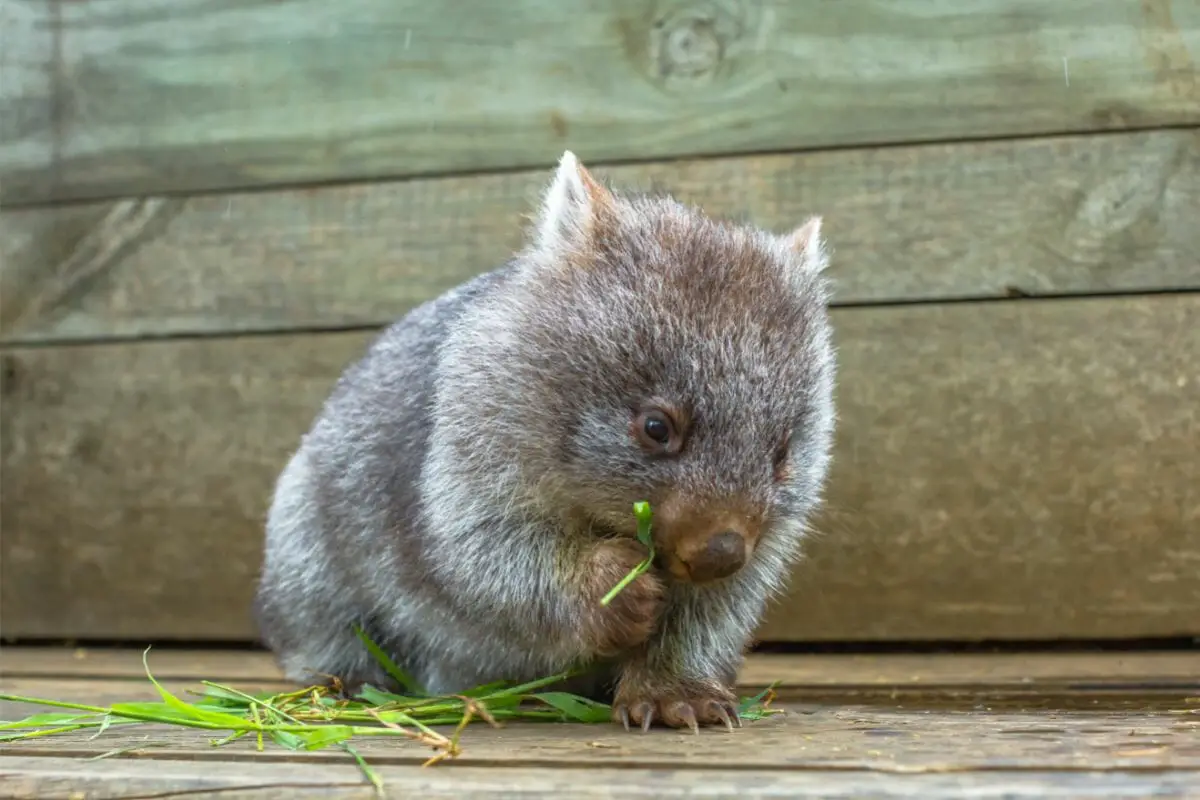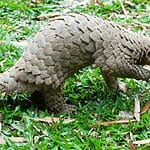Wombats are marsupials that are native to Australia. They may look like little bears, but they don’t act like them or eat like them either. So what do wombats eat? How varied is their diet?
Wombats primarily eat different types of grasses and in this article, we will discuss all your need to know about what wombats eat (Check out Is A Wombat An Omnivore?).

Are Wombats Herbivores, Carnivores, Or Omnivores?
Let’s begin by defining what these three terms mean and then we will look at what category wombats belong to.
Herbivores
Herbivores are animals that only eat plants and vegetables. They don’t consume any meat at all and have special digestive tracts that have evolved to handle and digest all of the different plant matter the animals may eat.
This can include plants, vegetables, grass, fruits, or seeds.
Vegetation doesn’t have as many nutrients as meat so many herbivores have to spend a large part of their day eating and grazing in order to get all of the nutrients and energy they need.
Carnivores
In contrast to herbivores, carnivores only eat the meat that comes from other animals.
Carnivorous animals hunt other animals for food and often need to consume large amounts of meat to sustain them. Carnivores usually have large canines and sharp molars to allow them to tear and chew meat.
Omnivores
Omnivores are animals that eat both meat and plants. They have the luxury of being able to find food from several different sources and can change their diet depending on what food is available in their environment.
Their diet can even change throughout the year depending on the season and what is available. Omnivores have a wide variety of different teeth that help them to tear and eat meat as well as plants.
What Category Do Wombats Belong To?
Wombats are herbivores as they only eat plants and their diet is primarily made from native grasses. As wombats are not built for hunting or eating meat, this is not part of their diet.
They don’t have the build or speed for catching and hunting other animals and they don’t have the correct teeth to tear and eat meat, either.
What Do Wombats Eat?
As we just learned, wombats are herbivores and they primarily eat grasses. Wombats live in Australia and their environment is covered by several different types of grassland and scrubland.
This means that wombats have an almost constant source of food without having to venture far to find it.
What Is The Most Common Food For Wombats?
The most common food for wombats to eat is snow grass. This is a type of tussock grass and has the scientific name Poa sieberiana.
This is their most common type of food because it is found everywhere across Australia and wombats don’t have to try hard to find it.
It’s a very hardy plant and has a high tolerance to the droughts that often plague Australia during the hot summer months.
What Other Grasses Do Wombats Eat?

Wombats favor other types of tussock grasses, too. These grasses usually grow as singular plants that group together in clumps, hummocks, tufts, or bunches.
It’s very unusual to see an even sod or lawn made from tussock grasses. They’re usually found in grasslands, prairies, and meadows.
Tussock grass is considered a perennial plant, so it will live for more than one season. It can thrive in both sun and shade and will often grow to heights of up to three feet high.
The other types of tussock grass that wombats commonly consume include wallaby grass and kangaroo grass. Both of these grasses grow across Australia in various areas.
They’re also hardy plants as they’re fire-tolerant and their grains have been used by native Australians for flour and porridge for millennia.
What Else Do Wombats Eat?
Apart from tussock grasses, wombats can also eat some other grasses and sedges. They will also eat the roots of some trees and shrubs if they have the opportunity.
Unfortunately for the farmers of Australia, wombats also have a taste for several different types of crops and this can cause problems.
How Do Wombats Find Their Food?
Wombats are foragers. As they’re nocturnal animals they’re most active during the night although colder weather can see them venture out during the days instead.
They prefer to avoid the heat of the summer months, however, and will only come out during the summer nights.
Wombats typically forage over a large area. They can wander for around one mile a day in search of food. When they do find something to eat, they eat in the same manner that most herbivores do.
They use their teeth to slice the plant matter before they eat it.
Wombat teeth are perfect for eating grass and roots as they’re very sharp and tough so they can easily get through the woody stems and fibrous grasses that make up their diet.
Eating these types of food can be tough on teeth, however, and wear them down. That’s why wombat teeth never stop growing.
They continue getting bigger and longer but the constant eating of grass wears them down and prevents them from ever overgrowing.
What Do Wombat Babies Eat?
But what about wombat babies? Do they eat grasses too? Known as joeys, wombat babies spend the first several months of their lives in the pouches of their mothers.
Wombats are marsupials, so when they’re born they are too small and weak to survive and instead finish growing inside their mother’s pouch.
Joeys will drink the milk of their mothers for at least 12 months before being weaned and moving on to solid food. At this point, they will eat grasses in the same way that adults do.
Final Thoughts
In this article, we learned that wombats are herbivores and they only eat plant matter. Generally, they eat tussock grasses such as snow grass, but they can also eat tree roots, shrub roots, and crops.
Inhabiting Australia, wombats, such as the common wombat and hairy-nosed wombats, live in burrows, particularly in regions like Tasmania and South Australia. These critically endangered creatures possess strong claws used for digging chambers and sleeping.
Their diet typically includes grasses and roots. The conservation efforts by the Australian government aim to preserve these nocturnal marsupials, combating land clearing and supporting their habitats amidst increasing challenges like competition for food and the ongoing threats to wombats they face, ensuring their survival in the wild.
Wombats, native to Australia and Tasmania, are herbivorous marsupials known for their nocturnal habits. Female wombats, after a gestation period of around 16 days, give birth to a tiny joey, barely the size of a jellybean.
Moreover, They dig extensive burrows, creating sleeping chambers and complex underground homes. While facing threats like habitat loss and diseases like sarcoptic mange, most wombat species, like the Tasmanian devils, are categorized as ‘least concern’ by the IUCN, offering hope for their conservation.
We hope that this article answered all of your questions about what wombats eat.









